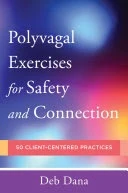This article explores the transformative power of Polyvagal Theory, as presented in Deb Dana's "Polyvagal Exercises for Safety and Connection," offering a compelling journey of self-discovery through understanding and regulating our autonomic nervous system. The book provides a framework, BASIC (Befriend, Attend, Shape, Integrate, Connect), to guide readers in developing a deeper understanding of their internal landscape and fostering resilience.

Understanding the Autonomic Hierarchy
Our autonomic nervous system operates on a hierarchy, influencing our responses to the world. This hierarchy, shaped by evolution, prioritizes survival. At the base is the dorsal vagal pathway, associated with shutdown and collapse. Above it lies the sympathetic nervous system, responsible for fight-or-flight responses. At the top is the ventral vagal pathway, linked to safety, connection, and social engagement. Understanding this hierarchy is crucial for recognizing how our bodies respond to different situations and for developing strategies to regulate our responses. (Polyvagal Exercises for Safety and Connection 50 Client-Centered Practices (Norton Series on Interpersonal Neurobiology) (Deb Dana) (Z-Library).Pdf, n.d., pp. 232-233,235-236)
The book emphasizes that the experience of being a professor, while demanding, provides a powerful skillset transferable outside academia. Internalizing these experiences as preparatory fosters adaptive resilience, leading to improved mental and physical health, expansive thinking, and rewarding social interactions. Conversely, a passive stance towards institutional definitions of success can lead to frustration and disappointment. (Polyvagal Exercises for Safety and Connection 50 Client-Centered Practices (Norton Series on Interpersonal Neurobiology) (Deb Dana) (Z-Library).Pdf, n.d., pp. 12–13)
Befriending the Autonomic Nervous System
The "Befriend" stage of the BASIC framework involves developing an accurate awareness of our autonomic states. This involves noticing subtle shifts in our bodies, identifying the physical sensations associated with each pathway (ventral vagal, sympathetic, dorsal vagal), and labeling these sensations with words. The book offers various exercises to cultivate this awareness, including creating autonomic alphabets, writing autonomic short stories, and using art and nature as anchors for ventral vagal regulation.
The author's personal journey, involving the development and application of Polyvagal Theory, highlights the importance of translating research into practice. This personal goal led to the creation of this book, which aims to empower clinicians and clients alike to utilize Polyvagal Theory as a practical guide for understanding and managing the body's responses to safety, danger, and life threats.
Shaping and Integrating Autonomic Responses
The "Shape" and "Integrate" stages focus on actively shaping our autonomic responses. This involves setting autonomic goals, using techniques like breathing exercises, mindful movement, and connecting with nature and art to promote ventral vagal regulation. The book provides numerous exercises to facilitate this process, including the use of "glimmers" (micro-moments of ventral vagal experience) and the practice of re-storying (creating new narratives that reflect our evolving autonomic responses).
The book also emphasizes the importance of tracking progress. Studies show that tracking progress supports change, and the book provides simple evaluation tools to help clients monitor subtle shifts in their autonomic nervous system.
Connecting and Expanding Outward
The final stage, "Connect," emphasizes the importance of social engagement and connection. The book explores how our autonomic nervous system influences our social interactions and provides exercises to improve our ability to read social cues and navigate relationships more skillfully. This includes exercises focusing on the social engagement system, body language, and the use of art and music to foster connection.
Conclusion
"Polyvagal Exercises for Safety and Connection" offers a practical and empowering approach to understanding and regulating our autonomic nervous system. By combining theoretical knowledge with practical exercises, the book provides a roadmap for cultivating resilience, fostering connection, and navigating the complexities of daily life with greater ease and self-awareness. The book's emphasis on personal narratives and the integration of various therapeutic techniques makes it a valuable resource for both clinicians and individuals seeking to enhance their well-being. The author's personal journey adds a compelling layer to the book, demonstrating the transformative potential of Polyvagal Theory in both personal and professional contexts.

